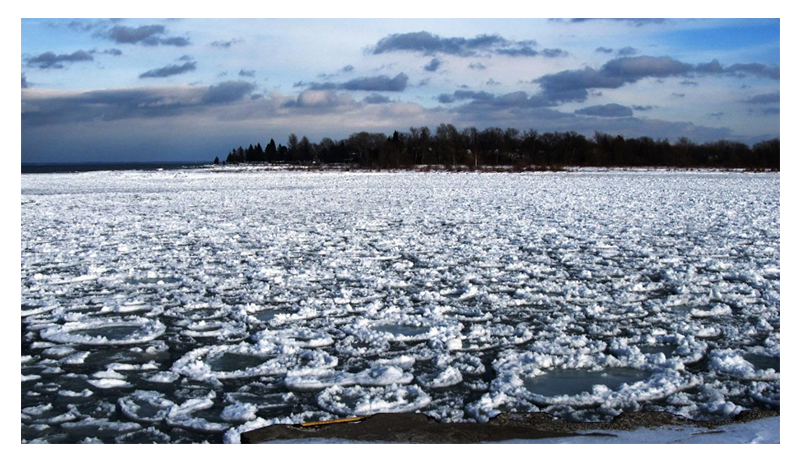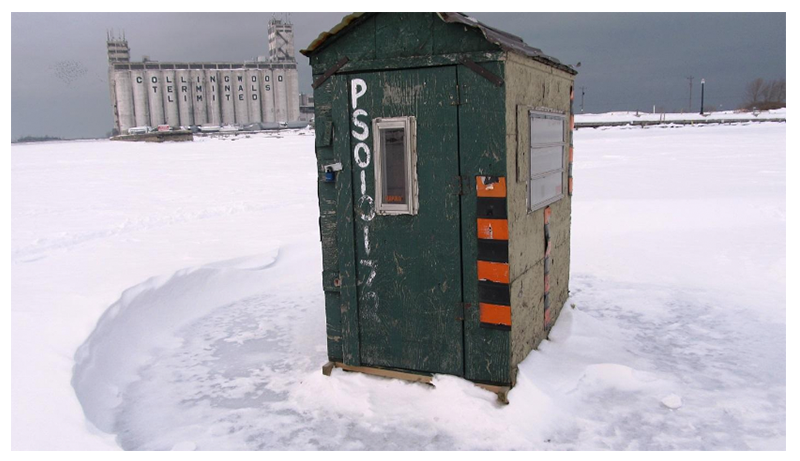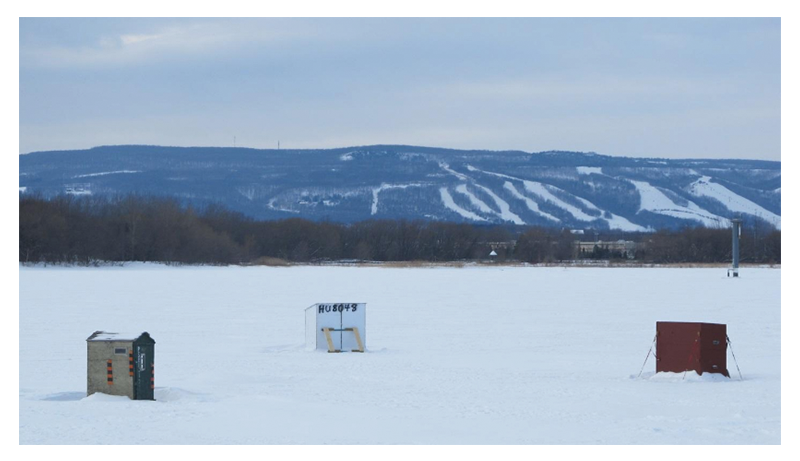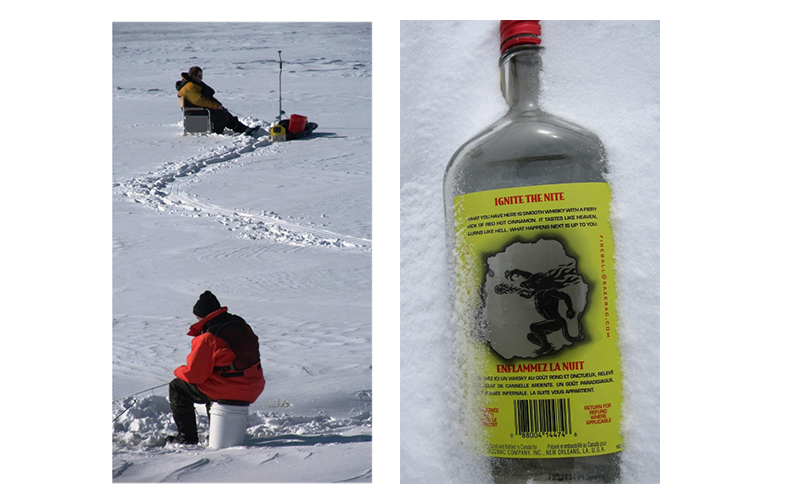A rising wall of snow-cloud and Canada geese flee the coming squall. From the sunroom at the back of my house I can track storms rolling in over the harbor. This winter, the impulse to step through that pane of glass hit me hard. There’s a magnetic force to Collingwood’s glinting harbor when it’s under ice. I figured that must be the appeal of ice fishing . . . why anglers are notorious for safeguarding their favorite spots. There was nothing for it but to trudge down to the Spit and enter that secret world.
The last few El Niño-warm Decembers, Nottawasaga Bay remained a stretch of midnight blue open water. This year, there’s a freeze-up. The wind off the bay has ground the pack ice, rounding off its edges to form giant lily-pads. Hank Barris, all-season fisherman from the age of ten, is jabbing at the ice with a four-foot chisel.
“If you can put your spud through the ice in one poke,” Barris says, “it’s not safe. For the best freeze-up you want 48 hours of calm . . . no wind and it’ll skip ice on it. You could drive your truck on black ice. Strong as the dickens. In the fall, it’ll go to honeycomb ice which is as long as a pencil and all squished together. It just shatters and disintegrates.”
“Have you had any close calls with all this melting and freezing?” I say, mincing toe-heel over a slippery minefield praying my new Yaktrax traction spikes hold up.
“You know that island at Northwinds Beach?” Barris says, “There can be three inches of ice but 50 yards away . . . open water! The wind’ll crack the ice and push you out into the bay.” He turns to face the shore, “If you look that way and a crack opens, that jump can very quickly become three feet. You keep all your gear in your bucket and run like hell.”
I try to imagine what it’s like to fish and hunt like Hank Barris. To hang loose, be in touch with elemental things. Then I remember the infamous ice slide outside the grade school portables. Every winter, nasty boys would groom it into a treacherous ice-slick. No matter how tightly I grasped the railing, my feet slipped out from under me. Oh the sting of Mercurochrome on my pebble-embedded knees!

In the June 3, 1837 Penny Magazine of the Society for the Diffusion of Useful Knowledge, Charles Knight describes how Chippewa Indians on Lake Huron cut fishing rods from willow trees and carved wooden decoys, “A hole is broken in the ice with a hatchet; a piece of wood carved into the shape of a fish, and colored to resemble one, having tiny fins and tail, and balanced by a piece of lead in the belly, is suspended in the water by a string of gut from a short stick which is held in the left hand.” Knight characterizes this activity as “an uncomfortable and cold mode of obtaining food.”
Next week, Barris takes a bowl of fish roe (“chum”) out of his beer fridge, “No real fisherman would buy bait from a store. That stuff is processed with borax to keep three months so always make your own bait. See how these fish eggs come in a skein like a saran-wrappy condom? As the eggs get close to being laid on the river bottom, they get looser and that skein separates. Once I got 400 roe bags from a ten pound female fish! First, we’re gonna form a ball of fish eggs about the size of a dime.”
I wrestle with a piece of icky, chartreuse-colored skein like a woman’s nylon stocking. It takes several tries to get my roe bag tightly wrapped. Barris adds two pieces of styrofoam to make it float, “Trout have an uncanny ability to really run with the line,” he says, “One time I tussled with a rainbow trout for 40 minutes. A real behemoth.”
On the big day, we’re all geared up: fishing rods, a spud, a gaffe, a hook, a skimmer to remove chipped ice from the hole after it’s cut, two 20-liter Hellman’s Mayonnaise pails, and a smaller pail with a Styrofoam lid.
“You don’t want your wet fishing line to freeze up,” Barris says, “so keep everything in your pail after you’re done fishing.”
The wind is pushing us across the ice as Barris hauls his collapsible ice hut . . . a four-feet by five-feet homemade box on skis. We walk halfway out on the harbor, stop for a few minutes, then keep walking . . . jackets undone so we don’t break a sweat and get cold. We trudge for ten minutes looking for footprints to see if someone else got here first.
“Believe it or not,” Barris says, “some guys’ll try to encroach on your spot. I’ve seen fistfights over a fishing hole ‘cause those cuckoo clocks think that’s where all the fish are. Duh! Fish are attracted to high quality bait, plain and simple. It’s better to fish solo. If you said you hooked 17 fish last Saturday, everybody and his brother would be out fishing. Sometimes there’s a lot of nosy questions: ‘How’re you makin’ out? Any bites?’ So I say: ‘Man, it’s slow as can be. Not a bite. Can’t remember what rainbow trout looks like.’”

In Buck Peterson’s Complete Guide to Fishing, Peterson writes: “You’ll set an example of fortitude to those girly-men using heated ice fishing houses by sitting directly on the ice with only a few essentials: chisel; skimmer; chair to keep your hemorrhoids from going into cold storage . . .” Barris and I shovel a section of snow and set up on the cleared patch. We pack loose snow around the edges to anchor our shelter then hunker down on the mayonnaise pails. Snow is banking up along the ice hut’s sides, ice needles drumming on the roof. Barris systematically spuds two fishing holes . . . he does 20 hits, takes a break, then another 20 hits.
The first time you peer down onto open water you almost swoon glimpsing a portal to a gleaming underworld. No light blocks our view so our fishing hole resembles a Sony Trinitron. A black hole . . . then clear, completely transparent ice.
When the time comes to bait our hooks with chum, the fish egg-smell reminds me of expired sushi. I override my gag reflex by squeezing a pressure point on my thumb. “Oh you go ahead,” I say, “I’ll just watch for now . . . So how do you know when your line hits the bottom?”
“It’s a feel thing. You let your line go down to the bottom. Loose, loose, loose. You reel it in till you can feel that weight then pull it up around 15 inches and set it on your pail. Your rod tip will dance around when the fish grabs the bait. A fish is slippery like soap. You can hand bomb it — wear a glove and grab it by the tail. Or you can use a gaffe hook — reach down and grab it behind the gills below the eyeballs.”
I could swear Barris summons the fish in his mind. As we’re peering down the hole, a pod of seven rainbow trout come in. My hands and knees tremble but the fish smell the bait and swim away. We sit in silence. When the trout swim in hard, a shimmery energy courses through them. They tail-smack the bait with tremendous force then swim two full loops.
“They’re trying to stun the b,ait,” Barris whispers, “If they hit the roe ball, it’ll do three spirals and go three feet away. When the tail hits, the fish’ll turn and eat the bait.”

I’ve always wondered how you locate the fish if they’re always swimming around. It turns out fish won’t move out of a space that’s about ten by 15 feet. Once you’ve cut your ice hole and drop down your bait, the fish are attracted to the bottom of your fishing hole.
A pulse jumps in my throat when the thrashing and ensnaring starts. All at once, Barris is setting the hook in a fish and reeling it in. 20 minutes to land an eight-pound rainbow, another ten minutes to hold the fish underwater and dislodge the hook.
I don’t get off scot-free when it comes to breaking the fish’s neck. “Hold it on an angle,” Barris barks, “and keep the head down so the heart will pump the blood out.” I say a prayer of atonement and place the exsanguinated fish (its mouth slightly torn) in the smallest pail. Light on the gray-blue ice is reflected in the styrofoam lid. We pack up and retrace our steps. Still no sign of cracks in the inner harbor, but farther out the ice is melting along the shoreline. Tossed in the back of the truck, our ice hut collapses like an inflatable lawn decoration.
I store my share of the catch in the crisper. The black speckles and pink side streak are already fading. After two days, the flesh decomposes so when I filet it, the pin bones come out easily. Brushed with olive oil and baked for 30 minutes, its straight-out-of-the-ice flavor is ambrosial.
•
I walk down to the Spit in late March. Two men are seated on an Igloo cooler out in the open by the old shipping terminals. When the first man waves me over, I’m careful not to ask: “How’re you makin’ out?”
“This here’s my productive spot,” he grins, “Get a lot of night bites.” He squeezes his rod handle to make the feathered hook undulate like fish bait. Staring into a slowly melting ice hole, the second man sighs, “Ah well, there’s always baked bean sandwiches.” As I struggle back to dry land, I spot a bottle embedded in a snowbank by the abandoned ice shanty village: Fireball Cinnamon Whisky: It Tastes like Heaven, Burns Like Hell. What Happens Next is Up to You.

Setting aside Charles Knight’s 1837 diss (“an uncomfortable and cold mode of obtaining food”), who wouldn’t want to ice fish? The outside temperature is minus 25 and a chill radiates up from the plank floor but the shelter is cozy and you packed a thermos of turkey soup. The pinch of curry warms you from your toes while your face flushes with cold. Two hours of trolling flash by as you sit mesmerized in the vast silence. When you pack up your hard-won catch, sun on the ice-bound harbor resembles flickering ladders.
A trout’s belly is silver to mimic the surface of the water while its blue-green back mirrors the river bottom. There are 17 miraculous kinds of ice: black ice, blue ice, pack ice, chip ice, honeycomb ice, frazil ice . . . You now understand in your bones how it is that ice builds up from the top not the bottom and why local fishermen call it “come-and-go ice.” •
Featured image by Isabella Akhtarshenas. All other images courtesy of the author.




